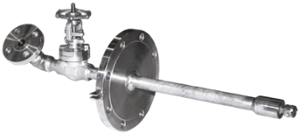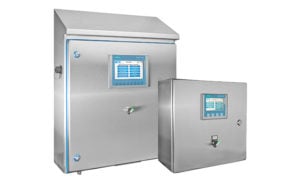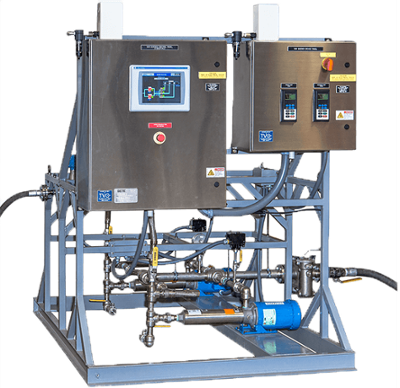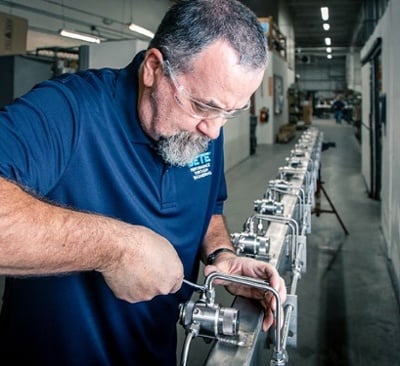Improve Your Process with Custom Spray Technology Fabrications
Use BETE spray lances, injectors, and quills for tank cleaning, gas cooling and conditioning, NOx control, chemical injection, or wash water injection.
BETE's spray injectors create stable conditions for the safe and efficient operation of downstream plant components. Avoid wall wetting, pipe corrosion, costly repairs, and unscheduled outages from occurring with spray injection solutions from BETE.
Refineries and chemical plants have counted on BETE for decades to supply complete fabricated assemblies, custom designed from the nozzle up. Starting with the process conditions, we recommend the most appropriate nozzle and then incorporate it into an assembly that meets all mechanical design criteria.
Injection Lances and Quills, Chemical Injectors or Spray Lances – BETE works to your requirements, from the most simple to the most complex. Incorporation of client specifications is routine for us, as is design, fabrication, and inspection to code requirements. All design and fabrication work is performed at the same facility, ensuring close coordination through all phases of the process to ensure all mechanical, performance, and inspection requirements are met.
BETE Spray Analysis and Custom Spray Lances (PDF – 125 KB)
BETE Spray Lance Design Intake Sheet (PDF – 70 KB)
Retractable Lance Instructions (PDF – 3.2 MB)
Spray Lances & Injectors
Tank Cleaning Lances
- Pipe & Flange
- Stationary or Retractable
- Used for precise placement inside a vessel
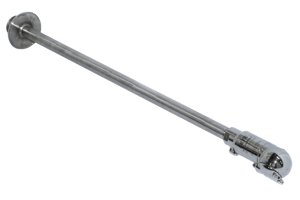
Spray Lances Injectors
- Drop-in Solution
- Single or Two-Fluid Air Atomizing Spray Nozzles
- Complex Code Compliant Fabrications
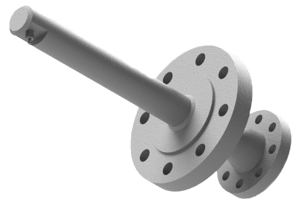
Retractable Lances
- Inspect & Service Nozzles Without Disrupting Process
- Options include lance, isolation valve, drain valve, and retraction mechanism
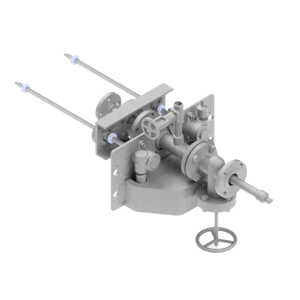
Common Design Requirements:
- ASME B31.3 – Process Piping
- ASME B31.1 – Power Piping
- Boiler External Piping (PP Authorization)
- Nonboiler External Piping
- ASME Boiler and Pressure Vessel Code Section VIII, Division 1 (U and UM Authorizations)
- Welding qualification to ASME B&PVC, Section IX
- Canadian Registration (CRN)
- NACE compliance
Common Materials:
- Stainless Steel
- Nickel Alloys
- Carbon Steel
Mechanical Inspections
- RT – Radiographic
- UT – Ultrasonic
- PT – Visible Dye Penetrant
- Hydrostatic
- Hardness
- PMI – Positive Material Identification
Performance Inspections
- Flow
- Spray Angle
- Cone Shape
- Droplet Size
- Special Customer Requirements
Maintenance without downtime
Why Use Retractable Lances?
A retractable lance allows you to withdraw your nozzle, isolate it from the process, and then remove it completely for servicing without taking your process offline. Once the nozzle is serviced, cleaned, or inspected; simply reattach it to the system, open the isolation valve, and insert it back into the process. This is often a critical requirement for petrochemical facilities where process outages are costly. For example, certain applications involved in the production of petroleum contain particles that are very erosive. The ability to remove the nozzle for refit while keeping the process online offers a tremendous cost savings.
For smaller size retractable lances, the lance pipe can be inserted and withdrawn manually. For larger sizes, or any size where automation or ease of use is required, BETE offers a robust retraction mechanism that effortlessly moves the lance from extended to inserted and back. A simple cordless drill is all that is required to power the unit, making this design a favorite with maintenance crews. The mechanism is flexible in its configuration; allowing alternate electric, pneumatic, or hydraulic power sources to drive the unit.
Custom BETE Spray Lance Solutions:
Sour Water Injection: TF 24XPN Retractable Spray Lance
Gas Cooling: Custom XAPR Spray Lance Design
Toulene Injection into Process Stream: Special XA Lance Assembly
Chemical Processing: Tank Washing Lance with Custom Quick-disconnect Connections
Odor Control Scrubbing at Coffee Roasting Company: 4″ TF 8 FCN Lance Assembly
Cryogenic Injection of Liquid Nitrogen: Lance assembly with right-angle TFXW
Light Cycle Oil (LCO) Quench of Hydrocarbon Gas Stream: Special MaxiPass Lance
Cooling Water in Refining Regenerator Vessel: Retractable SpiralAir Lances
Material Injection with Co-current Spray: Flanged TF Lance
Venturi Scrubbing: Special 3″ SpiralAir Lance
Fluid Injection: Custom Quill Fabrication
Oil Quench in Ethylene Process: MaxiPass 1000N Lance
Coating Centrifugal Casting Molds: 30′ XAFF Lance
Gas Cooling, Quenching: Titanium lance with multiple Twist & Dry spray drying nozzles
Geothermal Steam Water Scrubbing: Right-angle lance with WL nozzles on custom manifold
Material Injection: Special Quick-disconnect Lance
Gas Scrubbing at Incineration Facility: SpiralAir lance with quick-disconnects
Flue Gas Quenching: 1-1/2″ SpiralAir 2301-B-10
Injection of Liquid Hydrocarbon into Gas Stream: High Turndown Injector
Testing & Validation
BETE’s integrated engineering, quality, and manufacturing departments combine to meet virtually any code, testing, or inspection requirement.
Mechanical Inspection:
- RT –Radiographic
- UT –Ultrasonic
- PT –Visible Dye Penetrant
- Hydrostatic
- Hardness
- PMI –Positive Material Identification
Performance Inspections:
- Flow
- Spray Angle
- Cone Shape
- Droplet Size
- Special Customer Requirements
